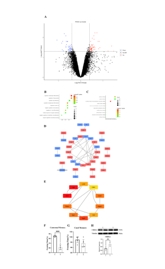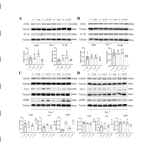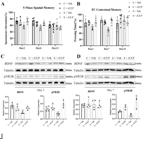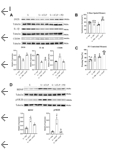#br#
NRR:南京鼓楼医院顾小萍团队发现主要由星形胶质细胞分泌的Chil1编码几丁质酶-3样蛋白1调节M2小胶质细胞极化改善术后认知功能障碍
撰文:韩雪,刘羽佳
术后认知功能障碍(Postoperative
cognitive dysfunction, POCD)指麻醉手术后出现的中枢神经系统并发症,主要特征为人格改变、社交能力受损和认知功能障碍[1]。POCD 与各种不良结果相关,包括功能恢复不良、住院时间延长、生活质量降低以及并发症和死亡率增加,引起临床广泛关注[2]。POCD涉及多种可能的病理机制,包括神经炎症、氧化应激和失调的自噬等 [3],其中神经炎症是以小胶质细胞激活并释放多种细胞毒性因子损伤神经元为特征。然而,由于POCD发病机制的复杂性,目前仍没有有效可行的治疗方案。第二代基因测序、微阵列技术和生物信息学分析能够识别与疾病发生和发展相关的基因和基因网络,包括诊断生物标志物和治疗靶点。Wei等人利用微阵列分析技术鉴定了POCD模型小鼠海马中的长链非编码(lnc) RNAs 和 miRNAs [4]。随着新的基因-基因和基因-功能关系的发现,生物信息学数据库的不断更新,需要重新探索与分析POCD发病机制中潜在的核心基因为今后的研究提供新的研究方向和治疗靶点。
南京大学医学院附属鼓楼医院顾小萍教授团队在《中国神经再生研究(英文)》(Neural Regeneration Research)2025年第9期发表的研究通过对POCD模型小鼠海马组织产生的基因表达数据集 GSE95426进行分析,发现了与“免疫细胞调节”生物过程密切相关的枢纽基因Chil1, 接着建立了胫骨骨折髓内固定术作为POCD模型验证了编码蛋白在POCD小鼠海马组织中的表达。Chil1编码几丁质酶-3样蛋白1 (chitinase-3-like
protein 1), CHI3L1主要由星形胶质细胞分泌,被认为是几种与神经炎症相关的神经系统疾病的生物标志物, 作者进一步探索了POCD小鼠模型中CHI3L1的重要作用,发现重组(r)CHI3L1治疗可以通过ERK调节的M2小胶质细胞极化缓解POCD小鼠模型的神经炎症并改善学习和记忆能力下降。CHI3L1可能是POCD机制研究的重要靶点,为POCD的治疗提供新的研究方向。
随着二代测序和微阵列技术的发展,利用生物信息学方法分析高通量大数据,为筛选疾病的标志物和关键靶点提供了新的方法[5]。本研究首先使用R语言中Aglip 扩展包对POCD 微阵列数据集进行原始数据前处理,bowtie2 将平台信息探针序列转化为对应的基因名,LIMMA 扩展包将处理后的芯片数据按线性模型进行分组差异比较,并转换为对应的基因名,通过确定的筛选标准初步筛选出差异表达的基因(图1 A),并使用 clusterProfiler 扩展包对101个差异基因进行 GO 富集分析和 KEGG 通路富集分析进行GO 和 KEGG 通路富集等多维度分析(图1B,C),然后利用Cytoscape 软件对蛋白互作网络进行可视化,并使用 Cytohubba 插件中的聚集系数算法筛选出了参与 POCD 发生发展的差异关键基因Chil1(图1D,E)[6, 7],在POCD小鼠模型海马组织中发现Chil1编码蛋白CHI3L1表达上调(图1F-H)。
接着对Chil1在 POCD 中的作用进行研究,主要探究了CHI3L1重组蛋白(recombinant chitinase-3-like protein 1,rCLP)对术后海马神经炎症和认知功能的影响。首先通过对POCD小鼠腹腔注射CHI3L1 重组蛋白,发现与单纯手术组(S组)相比,S+rCLP组小鼠海马组织中细胞因子iNOS、IL-1β表达明显下调(图2A,B),M2小胶质细胞标记蛋白Arg-1和CD206以及蛋白pERK的表达明显上调(图2C,D)。以上结果表明重组CHI3L1可减轻POCD小鼠海马神经炎症,促进海马M2小胶质细胞极化。接着采用条件恐惧测试和Y迷宫测试来检测重组CHI3L1给药对POCD小鼠不同时期情境记忆和空间记忆的影响。Y迷宫测试结果显示在术后第2 和6天, S + rCLP组自发轮替百分比较S + Veh组明显增加 (图3A)。条件性恐惧测试发现,S +
rCLP组在术后第3、7天的僵直时间百分比较S + Veh组显著增加(图3B)。Western Blot检测结果也发现术后第3、7天S + rCLP组海马组织中认知相关蛋白BDNF、pNR2B较S + Veh组明显升高(图3C,D)。以上结果表明,CHI3L1 重组蛋白可减轻术后不同时间点的空间记忆和情景记忆障碍。
最后探讨Chil1在 POCD 中发挥作用的可能机制。因此,作者继续研究 CHI3L1 是否是通过促进海马M2 小胶质细胞极化来改善术后神经炎症和认知功能障碍。利用M2小胶质细胞极化的通路蛋白 ERK 的抑制剂 PD98059(以下简称 PD)来干预 CHI3L1处理的胫骨骨折髓内固定术的小鼠。 PD98059与重组CHI3L1复合处理后,检测海马组织中M2小胶质细胞标志物蛋白CD206及细胞因子(iNOS、IL-1β)的表达,发现与S + rCLP组相比,S + PD + rCLP组CD206显著降低,iNOS、IL-1β显著升高(图4A)。在学习和记忆方面,Y迷宫测试结果显示S + PD + rCLP组与S + rCLP组相比,自发轮替百分比明显减少(图4B)。与Y迷宫测试结果相似,S + PD + rCLP组在条件性恐惧测试中僵直时间百分比较S + rCLP组显著减少 (图4C)。western blot结果显示,S + PD + rCLP组海马组织中认知相关蛋白BDNF、pNR2B的表达较S + rCLP组显著降低(图4D)。以上结果表明,ERK 的抑制剂 PD 可抑制 CHI3L1 对 M2 小胶质细胞极化的促进作用,从而阻断 CHI3L1 对胫骨骨折髓内固定术后神经炎症和认知障碍的改善作用。

图1 通过生物信息学分析和实验验证发现 Chil1 是参与 POCD 的枢纽基因。(图源:Liu et
al., Neural Regen Res 2025)

图2 重组CHI3L1可减轻POCD小鼠的神经炎症,促进海马M2小胶质细胞极化(图源:Liu et
al., Neural Regen Res 2025)

图3 重组CHI3L1可改善POCD小鼠的学习记忆功能障碍(图源:Liu et
al., Neural Regen Res 2025)

图4 CHI3L1可能通过M2小胶质细胞极化缓解POCD小鼠的神经炎症,改善术后学习记忆功能障碍。(图源:Liu et
al., Neural Regen Res 2025)
#br#
POCD 的发生涉及多种可能机制,其中神经炎症在 POCD 的发生发展中发挥重要作用[3]。但目前 POCD 的研究思路和相关靶点及多借鉴于其他中枢神经退行性病变,如阿尔茨海默病、帕金森病等[8, 9]。POCD具体的病理生理学过程与这些疾病存在差异,寻找 POCD 的特异性靶点能为疾病提供新的思路方向。作者使用生物信息学方法从POCD的微阵列芯片数据中筛选了与POCD和神经炎症相关的差异关键基因Chil1,Chil1编码蛋白CHI3L1(Chitinase-3-like protein 1),是一种43kDa的分泌性糖蛋白,在癌症浸润,免疫调节,炎症调节等生物学领域被广泛研究。在阿尔茨海默病的早期阶段,血浆及脑脊液中CHI3L1均有显著升高,和淀粉样前体蛋白、β-淀粉样蛋白具有关联性,并随着疾病进展呈升高趋势,提示CHI3L1可作为炎症标记物,在炎症的发生发展中起到关键作用[10, 11],也用于预测认知障碍的进展程度[12]。因此,作者重点研究了 Chil1编码蛋白CHI3L1对胫骨骨折髓内固定术后小鼠海马神经炎症和认知功能的影响,明确了 CHI3L1 可通过磷酸化 ERK 信号蛋白介导 M2 小胶质细胞极化减轻神经炎症,改善术后认知功能障碍。然而现有的研究中 CHI3L1 对炎症生物学作用存在争议,CHI3L1 抑制剂可减轻 Aβ 诱导的 BV-2 细胞炎症和认知障碍[13],但敲除 CHI3L1 后却又引起了中枢炎症的加重[14],这可能是由于 CHI3L1 的表达量差异发挥了不同的生物学作用导致[15]。
原文链接:https://doi.org/10.4103/NRR.NRR-D-23-01233
参考文献
[1] Liu
J, Huang K, Zhu B, et al. Neuropsychological tests in post-operative cognitive
dysfunction: methods and applications. Front Psychol. 2021;12:684307
[2] Evered
L, Silbert B, Scott DA, et al. Cerebrospinal Fluid Biomarker for Alzheimer
Disease Predicts Postoperative Cognitive Dysfunction. Anesthesiology.
2016;124:353-361.
[3] Liu Y, Fu
H, Wang T. Neuroinflammation in perioperative neurocognitive disorders: From
bench to the bedside. CNS Neurosci Ther. 2022;28:484-496
[4] Wei C,
Luo T, Zou S, et al.. Differentially expressed lncRNAs and miRNAs with
associated ceRNA networks in aged mice with postoperative cognitive
dysfunction. Oncotarget. 2017;8:55901-55914.
[5] Xu W,
Seok J, Mindrinos MN, et al. Human transcriptome array for high-throughput
clinical studies. Proc Natl Acad Sci U S A. 2011;108:3707-3712.
[6] Chin CH,
Chen SH, Wu HH, et al. cytoHubba: identifying hub objects and sub-networks from
complex interactome. BMC Syst Biol. 2014;8 Suppl 4:S11.
[7] Parra-Medina
R, Lopez-Kleine L, Ramirez-Clavijo S, et al. Identification of candidate miRNAs
in early-onset and late-onset prostate cancer by network analysis. Sci Rep.
2020;10:12345.
[8] Li
XM, Shao MT, Wang JJ, et al. Relationship between
post-operative cognitive dysfunction and regional cerebral oxygen saturation
and β-amyloid protein. J Zhejiang Univ Sci B. 2014;15:870-878.
[9] Kim
KH, Kang SY, Shin DA, et al. Parkinson's disease-related
non-motor features as risk factors for post-operative delirium in spinal
surgery. PLoS One. 2018;13:e0195749.
[10] Connolly
K, Lehoux M, O'Rourke R, et al. Potential role of chitinase-3-like protein 1
(CHI3L1/YKL-40) in neurodegeneration and Alzheimer's disease. Alzheimers Dement.
2023;19:9-24.
[11] Muszynski
P, Groblewska M, Kulczynska-Przybik A, et al. YKL-40 as a potential biomarker
and a possible target in therapeutic strategies of Alzheimer's disease. Curr
Neuropharmacol. 2017;15:906-917
[12] Baldacci
F, Lista S, Cavedo E, et al. Diagnostic function of the
neuroinflammatory biomarker YKL-40 in Alzheimer's disease and other
neurodegenerative diseases. Expert Rev Proteomics. 2017;14:285-299.
[13] Choi JY,
Yeo IJ, Kim KC, et al. K284-6111 prevents the amyloid beta-induced
neuroinflammation and impairment of recognition memory through inhibition of
NF-kappaB-mediated CHI3L1 expression. J Neuroinflammation. 2018;15:224
[14] Im
JH, Yeo IJ, Park PH, et al. Deletion of Chitinase-3-like 1
accelerates stroke development through enhancement of Neuroinflammation by
STAT6-dependent M2 microglial inactivation in Chitinase-3-like 1 knockout mice.
Exp Neurol. 2020;323:113082.
[15] He CH,
Lee CG, Dela Cruz CS, et al. Chitinase 3-like 1 regulates cellular and tissue
responses via IL-13 receptor alpha2. Cell Rep. 2013;4:830-841.
#br#
#br#



